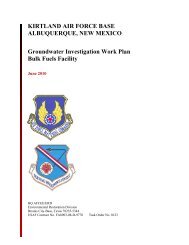Final FONSI and EA for hot cargo pad on Kirtland AFB - Kirtland Air ...
Final FONSI and EA for hot cargo pad on Kirtland AFB - Kirtland Air ...
Final FONSI and EA for hot cargo pad on Kirtland AFB - Kirtland Air ...
You also want an ePaper? Increase the reach of your titles
YUMPU automatically turns print PDFs into web optimized ePapers that Google loves.
<str<strong>on</strong>g>Final</str<strong>on</strong>g> <str<strong>on</strong>g>EA</str<strong>on</strong>g> Addressing C<strong>on</strong>structi<strong>on</strong>, Operati<strong>on</strong>, <str<strong>on</strong>g>and</str<strong>on</strong>g> Maintenance of a Hot Cargo Pad<br />
3.7.2.4 Threatened <str<strong>on</strong>g>and</str<strong>on</strong>g> Endangered Species<br />
The agencies that have primary resp<strong>on</strong>sibility <str<strong>on</strong>g>for</str<strong>on</strong>g> the c<strong>on</strong>servati<strong>on</strong> of plant <str<strong>on</strong>g>and</str<strong>on</strong>g> animal species in New<br />
Mexico are the USFWS; the NMDGF; <str<strong>on</strong>g>and</str<strong>on</strong>g> the New Mexico Energy, Minerals, <str<strong>on</strong>g>and</str<strong>on</strong>g> Natural Resources<br />
Department. These agencies maintain lists of plant <str<strong>on</strong>g>and</str<strong>on</strong>g> animal species that have been classified, or are<br />
potential c<str<strong>on</strong>g>and</str<strong>on</strong>g>idates <str<strong>on</strong>g>for</str<strong>on</strong>g> classificati<strong>on</strong>, as threatened or endangered in Bernalillo County. Of those species<br />
known to occur in the county, two Federal species of c<strong>on</strong>cern (western burrowing owl [Athene<br />
cunicularia hypugaea] <str<strong>on</strong>g>and</str<strong>on</strong>g> mountain plover [Charadrius m<strong>on</strong>tanus]), <str<strong>on</strong>g>and</str<strong>on</strong>g> <strong>on</strong>e state threatened species<br />
(gray vireo [Vireo vicinior]) have the potential to occur in the project area.<br />
Gray vireo. The gray vireo (Vireo vicinior), a state threatened species, as listed by the NMDGF, is the<br />
<strong>on</strong>ly federally or state-listed species known to occur <strong>on</strong> the installati<strong>on</strong>. The USFWS c<strong>on</strong>siders the gray<br />
vireo a sensitive species. In 2003, an installati<strong>on</strong>wide gray vireo survey was c<strong>on</strong>ducted in which<br />
53 territories were mapped (K<strong>AFB</strong> 2004a). Territories were found throughout the juniper woodl<str<strong>on</strong>g>and</str<strong>on</strong>g><br />
community in an elevati<strong>on</strong>al belt of 5,850 to 6,600 feet. Gray vireos occupied areas with an open canopy<br />
(i.e., less than 25 percent) with <strong>on</strong>e seeded juniper as the dominate tree/shrub species (K<strong>AFB</strong> 2007).<br />
Western burrowing owl. The western burrowing owl (Athene cunicularia hypugaea), a Federal species<br />
of c<strong>on</strong>cern, is a comm<strong>on</strong> resident at Kirtl<str<strong>on</strong>g>and</str<strong>on</strong>g> <strong>AFB</strong>. It is very closely associated with the prairie dog<br />
col<strong>on</strong>ies <strong>on</strong> the installati<strong>on</strong>, as they use ab<str<strong>on</strong>g>and</str<strong>on</strong>g><strong>on</strong>ed prairie dog burrows <str<strong>on</strong>g>for</str<strong>on</strong>g> nesting <strong>on</strong> Kirtl<str<strong>on</strong>g>and</str<strong>on</strong>g> <strong>AFB</strong><br />
during summer m<strong>on</strong>ths. Owls generally occur <strong>on</strong> the installati<strong>on</strong> between March <str<strong>on</strong>g>and</str<strong>on</strong>g> October be<str<strong>on</strong>g>for</str<strong>on</strong>g>e<br />
migrating south, although a few birds might occur <strong>on</strong> the installati<strong>on</strong> during mild winters. Burrowing owl<br />
inventories have been c<strong>on</strong>ducted every year since 1994, <str<strong>on</strong>g>and</str<strong>on</strong>g> in 2005 a migrati<strong>on</strong> study was initiated to<br />
identify where nesting owls at Kirtl<str<strong>on</strong>g>and</str<strong>on</strong>g> <strong>AFB</strong> go to winter. Since burrowing owls use old prairie dog<br />
burrows <str<strong>on</strong>g>for</str<strong>on</strong>g> nesting, a Prairie Dog Management Plan was developed <str<strong>on</strong>g>for</str<strong>on</strong>g> the installati<strong>on</strong>, which takes into<br />
account burrowing owl habitat requirements (K<strong>AFB</strong> 2007). Figure 3-8 shows potential prairie dog<br />
habitat <str<strong>on</strong>g>and</str<strong>on</strong>g> burrowing owl locati<strong>on</strong>s (observed 15 July 2009) at Kirtl<str<strong>on</strong>g>and</str<strong>on</strong>g> <strong>AFB</strong>. Although not depicted <strong>on</strong><br />
Figure 3-8, prairie dogs have been observed within the QD arcs <str<strong>on</strong>g>for</str<strong>on</strong>g> the exiting <str<strong>on</strong>g>and</str<strong>on</strong>g> proposed <str<strong>on</strong>g>hot</str<strong>on</strong>g> <str<strong>on</strong>g>cargo</str<strong>on</strong>g><br />
<str<strong>on</strong>g>pad</str<strong>on</strong>g>s.<br />
Mountain plover. Mountain plovers (Charadrius m<strong>on</strong>tanus), a Federal species of c<strong>on</strong>cern, are not known<br />
to occur <strong>on</strong> the installati<strong>on</strong>. However, in 2003, an adult with two chicks was observed just south of the<br />
installati<strong>on</strong> <strong>on</strong> the Isleta Pueblo Indian Reservati<strong>on</strong> (K<strong>AFB</strong> 2004a). Appropriate nesting habitat <str<strong>on</strong>g>for</str<strong>on</strong>g> this<br />
species is limited <strong>on</strong> the installati<strong>on</strong>; there<str<strong>on</strong>g>for</str<strong>on</strong>g>e, it is unlikely that the mountain plover uses Kirtl<str<strong>on</strong>g>and</str<strong>on</strong>g> <strong>AFB</strong><br />
during the nesting seas<strong>on</strong>. However, the southern grassl<str<strong>on</strong>g>and</str<strong>on</strong>g>s of the installati<strong>on</strong> could potentially be used<br />
as brood-rearing habitat or during migrati<strong>on</strong> (K<strong>AFB</strong> 2007).<br />
Santa Fe milkvetch. Santa Fe milkvetch (Astragalus feensis), a rare plant in New Mexico, is known or<br />
expected to occur <strong>on</strong> Kirtl<str<strong>on</strong>g>and</str<strong>on</strong>g> <strong>AFB</strong> (K<strong>AFB</strong> 2008d). Santa Fe milkvetch is found <strong>on</strong> gravelly hillsides in<br />
piny<strong>on</strong>-juniper woodl<str<strong>on</strong>g>and</str<strong>on</strong>g> or plains-mesa grassl<str<strong>on</strong>g>and</str<strong>on</strong>g> (5,100 to 6,000 feet elevati<strong>on</strong>) (NMRPTC 1999).<br />
Critical Habitat<br />
Critical habitats are those areas of l<str<strong>on</strong>g>and</str<strong>on</strong>g>, air, or water that are essential <str<strong>on</strong>g>for</str<strong>on</strong>g> maintaining or restoring<br />
threatened or endangered plant or animal populati<strong>on</strong>s. Neither the NMDGF nor the USFWS has<br />
designated or identified any critical habitat <strong>on</strong> Kirtl<str<strong>on</strong>g>and</str<strong>on</strong>g> <strong>AFB</strong>. Surveys <str<strong>on</strong>g>and</str<strong>on</strong>g> literature indicate that<br />
important habitats <strong>on</strong> the installati<strong>on</strong> include the wetl<str<strong>on</strong>g>and</str<strong>on</strong>g>s, which are rare in the regi<strong>on</strong> <str<strong>on</strong>g>and</str<strong>on</strong>g> provide water<br />
in an otherwise arid envir<strong>on</strong>ment. Other important habitats <strong>on</strong> the installati<strong>on</strong> include prairie dog towns,<br />
which provide nesting habitat <str<strong>on</strong>g>for</str<strong>on</strong>g> the burrowing owl, <str<strong>on</strong>g>and</str<strong>on</strong>g> areas between 5,900 <str<strong>on</strong>g>and</str<strong>on</strong>g> 6,600 feet elevati<strong>on</strong><br />
c<strong>on</strong>taining open juniper woodl<str<strong>on</strong>g>and</str<strong>on</strong>g>s, which are used as nesting habitat by the gray vireo (K<strong>AFB</strong> 2007).<br />
Kirtl<str<strong>on</strong>g>and</str<strong>on</strong>g> <strong>AFB</strong>, NM January 2011<br />
3-25
















